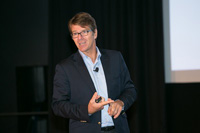
Association of Strategic Alliance Professionals

What a CEO Wants—and Doesn’t Want—in an Alliance Executive : A Peek inside the Mind of Mayoly Spindler CEO
Posted By John W. DeWitt, Thursday, September 08, 2016
From an alliance management perspective, how you would you describe your perfect CEO? After today, I might start with the handsome, articulate, and drily witty Stéphane Thiroloix, CEO of French pharmaceutical company Mayoly Spindler. Sharing a peek inside his mind as a company leader, today’s opening plenary speaker at the 2016 ASAP BioPharma Conference in Boston at one point described himself as “an anxious maniac” who secretly wishes to avoid meetings with some partners and worries over all the details he can’t remember about other partners.
Thiroloix opened his talk by describing his humiliation at the center of an unmitigated partnering disaster. A far cry from the historic lament of partnering executives—“the C-suite has no idea what we do”—Thiroloix talked in sufficient detail to demonstrate his thorough command of the ins and outs of strategic partnering and the alliance management role. He also described how he has pushed to expand the role of alliance management in his current company, which focuses on gastroenterology and dermocosmetics. Not surprisingly, the audience was hooked from start to finish.
Thiroloix backed up his talk by a handful of spare, almost minimalist slides (except for one animated slide that, I’m not kidding, showed a fairy flying around an org chart, waving her wand and sprinkling the magic dust of alliance management across the C-suite team). For nearly an hour of presentation and Q&A, Thiroloix riveted his audience of approximately 150 alliance executives by describing the importance of what they do and how they do it—from his perspective as a CEO.
After reviewing the sweeping shift, during the past 30 years, from a highly vertical and self-contained pharmaceutical industry to the highly interdependent industry of today, he noted the truism that “we cannot get away from partnering. Today, you can’t do that, regardless of who you are—you have to partner in pretty much everything you do.” Moreover, that means CEOs need to care very much about alliance management. “This really has projected your role to a central role in what we do in the healthcare industry.”
Then Thiroloix pivoted to the heart of his presentation. “Now I’d like to focus on the other aspect—the C-suite interaction with alliance management. There are a number of things that I’ve come to expect.”
For starters, alliance management should be a “one-stop shop” for anything involving partners. “We expect you to know everything about the partnership—if you don’t, who will?” he asked. “I don’t know everything about our partners and I develop anxiety about that. The only way to relieve that anxiety is to talk to you. It’s technically important [to provide this knowledge] and also an interesting element of career dynamics. This is about reassuring the C-suite.”
Indeed, he described in detail his expectations of “support for my team. We want to be informed, prompted and supported, and coordinated. I expect you to keep my team on the right page of that book, and help them to contribute to the health of that alliance.”
One of Thiroloix’s most powerful points then came when he described his perspective on importance of advocating for the partner—demonstrating just how clearly he sees the nuances of alliance management and its pivotal role in partnering success.
“I expect the alliance manager to put herself at risk at some point for the partner. Any C-suite will paint the picture the color they need it,” he explained. “The role of the alliance manager is to tell us, ‘you can’t do this because our partner is actually expecting the opposite,’ and to overcome the natural bias of executive committees.” As he did throughout his talk, Thiroloix then dug a layer deeper, explaining what he called a “survival skill” for alliance execs when they are advocating for the partner:
“Make sure you are clear it’s your opinion versus painting the picture for the partner. I expect the alliance manager to tell me, ‘Stéphane, this is how our partner sees it,’ then say, ‘I think they’re wrong and might be open to changing their minds,’ or, ‘I think they’re right and we need to change our approach.’”
He also emphasized the importance of telling senior leadership what they need to know about partners to do their jobs—but not what you might want them to know about your job and what it takes to do it.
“Alliance managers are same as everyone else standing in front of senior management,” he admonished. “We all tend to go over the whole story about every one of our partnerships when we get a little bit of ear time—but don’t do that, we know how hard you work. The C-suite doesn’t understand the job, the complexity—but they understand the need for this type of job.”

